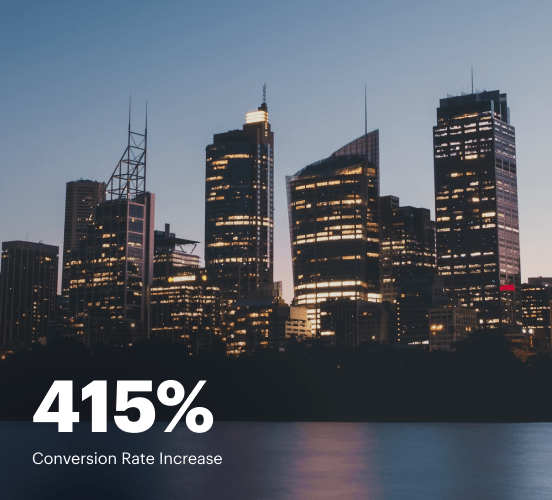Yola vs. Canva: the best platform for a seamless web experience
Discover how Yola compares to Canva regarding features and usability. Find out which platform provides the competitive advantage your business deserves.
Get startedSee how Instapage stacks up against the competition
| Feature | Instapage | Other builders |
| Drag-and-Drop Tools | ||
| Conversion-optimized templates | ||
| Manual and AI-powered A/B Tests | ||
| AI content suggestions | ||
| Popups and sticky bars | ||
| Canvas and grid blocks | ||
| Reusable and global elements | ||
| Form and popup builders | ||
| Built-in Heatmaps | ||
| Central analytics dashboard | ||
| Ad-to-page personalization and collections | ||
| Contacts, lists, and email | ||
| Dedicated, full-service CRO experts | ||
| Enterprise-ready platform |
Leading the way in building high-performing landing pages





Why Instapage is the smarter choice for your campaigns
Get everything you need to build, scale, and optimize high-converting landing pages—without coding.

Easier page building without coding
Instapage offers a flexible and seamless page creation experience with a library of 500+ conversion-focused layouts, Instablocks®, a drag-and-drop builder, and AI content generation. With technologies like Thor Render Engine®, you can create on-brand, mobile-responsive landing pages that load quickly and start converting during initial visitor clicks.

More insights — better results
Instapage lets you see in detail how each landing page experience and variation is performing so you can make targeted changes that boost page conversions. Use heatmaps for a better understanding of on-page activities, run A/B tests and AI-assisted experiments, and then track and evaluate results within robust analytics dashboards.

More personalized experiences
Instapage lets you quickly create high-performing landing pages tailored to each of your ad campaigns. Deliver personalized experiences for distinct audiences using dynamic text replacement. Effortlessly align specific advertisements to unique pages with AdMaps. Monitor audience-level metrics using our advanced data tools.

Built-in collaboration
Instapage collaboration capabilities bring your entire team together to speed up the process of landing page review, approval, and launch. No more frustrating and unnecessary revisions or edits scattered across emails. Provide instant feedback, conduct real-time page edits, and securely share your pages with outside stakeholders.

Free up time for your business
Invest time into business growth, not busy work. Launch landing pages faster with reusable forms and templates. Build once, reuse forever.
Explore all integrations






Easier page building without coding
Instapage offers a flexible and seamless page creation experience with a library of 500+ conversion-focused layouts, Instablocks®, a drag-and-drop builder, and AI content generation. With technologies like Thor Render Engine®, you can create on-brand, mobile-responsive landing pages that load quickly and start converting during initial visitor clicks.
More insights — better results
Instapage lets you see in detail how each landing page experience and variation is performing so you can make targeted changes that boost page conversions. Use heatmaps for a better understanding of on-page activities, run A/B tests and AI-assisted experiments, and then track and evaluate results within robust analytics dashboards.
More personalized experiences
Instapage lets you quickly create high-performing landing pages tailored to each of your ad campaigns. Deliver personalized experiences for distinct audiences using dynamic text replacement. Effortlessly align specific advertisements to unique pages with AdMaps. Monitor audience-level metrics using our advanced data tools.
Built-in collaboration
Instapage collaboration capabilities bring your entire team together to speed up the process of landing page review, approval, and launch. No more frustrating and unnecessary revisions or edits scattered across emails. Provide instant feedback, conduct real-time page edits, and securely share your pages with outside stakeholders.
Free up time for your business
Invest time into business growth, not busy work. Launch landing pages faster with reusable forms and templates. Build once, reuse forever.
Explore all integrationsGet started with Instapage in a few steps
-
Create your Instapage account
Start with Instapage by signing up via Google or your email. You'll get access to a free 14-day trial to discover Instapage capabilities. Feel free to cancel anytime during the 14-day trial if you decide that our product is not suitable for your business. -
Build and personalize your page
Create your first landing page from scratch or choose a template from 500+ customizable layouts. Use the drag-and-drop builder to add page elements, fonts, and backgrounds, refine content with AI, or add custom HTML, Javascript, and CSS. -
Review and make edits
Collaborate on page designs and streamline review processes. Invite your team members and stakeholders to review, edit, and provide feedback on your landing page. Collaborate knowing your page is confidential and only accessible to authorized users. -
Publish and track page performance
Publish your page to a domain or custom URL. Connect your pages to the ads you've created and track page performance within the analytics dashboard, run A/B tests and AI experiments, analyze results, and continuously optimize your landing page to maintain high conversions.
Yola vs. Canva: A Comprehensive Comparison with a Twist
Navigating the world of landing page builders can feel like trying to find your way through a maze without a map. With countless options, two platforms have emerged as popular contenders: Yola and Canva. Both provide users with unique solutions for their web design and marketing needs, but how do they truly stack up against each other? In this guide, we'll explore the features, usability, performance, support, and pricing strategies of Yola and Canva, with a surprising newcomer, Instapage, waiting in the wings. Grab your digital toolkit as we jump into this showdown and uncover which platform redefines ease of use and effectiveness for marketers everywhere. As we highlight the strengths and weaknesses of each, our goal is to shine a light on how these platforms cater to marketers of all skill levels, from beginners finding their footing to veterans honing their strategies. Dive in with us as we unpack this battle of the builders, ensuring you have all the insights you need to make an informed choice.
Introducing the Contenders
In the digital marketing domain, Yola and Canva are heavyweight champions, each with their distinct flavor of functionality. Yola is celebrated for its straightforward website-building capabilities, allowing users to create professional-looking sites without a coding background. It's like having a digital handyman at your service, ready to help you build your online presence effortlessly. On the flip side, Canva has taken the creative space by storm, offering an extensive arsenal of design tools that enable users to whip up visually stunning graphics, presentations, and more. Think of Canva as the artistic virtuoso, providing users with the tools to bring their ideas to life in a visually captivating way. But don’t forget the third competitor lurking in the background—Instapage—which is known for its specialization in high-converting landing pages. As we venture deeper into this comparison, we'll highlight what each platform brings to the table and how their strengths complement or contrast with one another.
Feature Face-Off: A Closer Look
When it comes to features, both Yola and Canva pull out all the stops to impress users. Yola boasts a variety of customizable templates and an intuitive drag-and-drop editor that simplifies the website creation process. Users can easily add elements, adjust layouts, and make their site truly representative of their brand. Meanwhile, Canva showcases an incredible library of design elements, templates, and stock images, allowing users to create anything from social media graphics to business cards in mere minutes. Both platforms are geared to provide user-friendly experiences, ensuring that marketers can focus on creativity rather than being bogged down by technicalities. However, as we mention the growing presence of Instapage, which focuses heavily on customization options specifically tailored for creating high-conversion landing pages, it's evident that there might be more players in this game; it’s not just a two-horse race.
Navigating Usability: Who’s the User-Friendly Champion?
As we delve into the usability of Yola and Canva, we notice a distinct focus on catering to their respective audiences. Yola is engineered for those who may be new to website creation, offering tutorials that transform the steep learning curve into a gentle incline. It’s like taking a scenic hike instead of a grueling uphill battle. Conversely, Canva caters to both novices and experienced designers alike, presenting an interface packed with tools that might initially daunt beginners but ultimately rewards them with endless creative possibilities. The key point here is that both platforms aim to make the user experience as seamless as possible, albeit diving into different depths of customization and creativity. While Yola’s focus leans toward website builders, Canva embraces the artistry across various media formats. Our takeaway? Whether you’re a rookie or a pro, both platforms bring something worthwhile to the table, though each does so in its unique way.
Distinct Features of Yola:
- Intuitive drag-and-drop website editor that simplifies the creation process
- Variety of customizable templates tailored for different businesses
- Built-in SEO tools to enhance visibility on search engines
- E-commerce functionality allowing users to sell products directly from their site
- Robust customer support including chat options and tutorials
Key Features of Canva:
- Extensive library of templates for various design needs
- User-friendly interface with easy access to design tools
- Collaboration features for team projects
- Access to millions of stock photos and design elements
- Ability to export creations in multiple formats for different platforms
Shared Features That Strengthen Both Platforms:
- Versatile templates that cater to various design requirements
- Drag-and-drop functionality enhancing user experience
- Accessibility across devices for on-the-go editing
- Integrated support resources such as FAQs and tutorials
- Ability to publish designs directly to social media platforms
- Focus on ensuring a seamless user experience with minimal technical struggles
As we round off the features, it’s clear that both platforms have distinct advantages. While Yola excels in creating functional websites, Canva's strength lies in graphic design versatility. Yet amidst these two contenders, Instapage stands as a formidable opponent, primarily focusing on landing page creation to drive conversions. Whether the focus is on building a comprehensive website or designing standout marketing materials, each platform has its unique strengths, making the competition enticing for users seeking tools that can elevate their marketing strategies.
Performance Showdown: Speed and Responsiveness
As we transition to performance, we must consider page loading times and mobile responsiveness, essential factors for user satisfaction and engagement. A slow-loading page can be compared to watching molasses drizzle on a winter morning; it’s excruciating, and no one wants to stick around for that! Yola is optimized for speed; however, depending on template complexity and the number of media elements, there may be instances where loading times fluctuate. Canva, primarily a design platform, ensures that images created and used maintain quality without sacrificing speed. When it comes to responsiveness, Yola’s designs are mobile-friendly, ensuring that users can access creations across various devices without a hitch. Canva also provides mobile templates, enabling users to produce designs that translate well on phones and tablets. Ultimately, both platforms try their best to keep users engaged, but as we’ll soon explore, Instapage specializes in landing pages designed for optimal conversion, considering speed as a critical component of user experience.
Support Systems: Who’s Got Your Back?
Looking into customer support, we can see how each platform aims to empower its users through available resources. Yola offers multiple support channels, including live chat and an expansive knowledge base filled with tutorials and articles to help users troubleshoot and maximize their experience. Canva also provides solid support, featuring an online community where users can share insights and feedback, coupled with a dedicated FAQ section. Both platforms ensure that users feel supported throughout their journey, reminiscent of having a trusty sidekick ready to swoop in with assistance. Additionally, each platform maintains an effective online presence, responding to user inquiries and fostering an environment where users can learn from one another. While both Yola and Canva have commendable support structures, Instapage also shines here by offering tailored support for optimizing landing pages specifically, ensuring users can achieve their marketing goals effectively.
Pricing Battle: Which Platform Offers More Value?
Pros of Yola's Pricing Strategy:
- Flexible pricing options catering to different business sizes
- Free tier available for users to test out features
- Affordable plans that include essential features for startups
- Clear value proposition for small to medium businesses
Pros of Canva's Pricing Strategy:
- Free version available with substantial features for beginners
- Affordable Pro subscription with added benefits for advanced users
- Discounted rates for educators and non-profits, fostering community use
- Easy upgrade options to access premium content without long-term commitment
- Value-packed bundles available for frequent users needing additional credits
When examining the pricing strategies, both Yola and Canva showcase transparency and value in their plans. Yola appeals to those seeking simplicity, while Canva excels in offering a broad range of design features at various pricing points. However, amidst these offerings lies Instapage, whose pricing strategy also stands out as flexible and accessible, making it a strong consideration for businesses looking for value while focusing on high-conversion strategies. The takeaway here is that regardless of budget constraints, finding a platform that aligns with your business needs is crucial.
Diving deeper into the pricing plans, users can appreciate that both platforms are designed to cater to various budgets without compromising on essential functionalities. This transparency allows users to select options that best align with their business goals and growth trajectories, highlighting potential areas for expansion based on individual needs. It’s essential to recognize that while Yola and Canva have their distinct pricing advantages, the experience and results may vary based on how platforms are utilized in real-world scenarios. Sometimes great value lies in the options that are least expected, so it's worth exploring.
And Then There’s Instapage...
As we wrap up this comprehensive comparison, Instapage emerges as the mentor quietly guiding users towards elevated marketing strategies. Known for its focus on creating landing pages, Instapage ensures that businesses can capitalize on conversions through thoughtful design and optimized performance metrics. One of its unique value propositions is the ability to track and analyze touchpoints that yield results—something the other platforms struggle to replicate fully. Bridging the gap between aesthetics and functionality, it cleverly positions itself not just as an alternative but as an exceptional tool for marketers who prioritize ROI. While Yola and Canva serve their respective purposes, Instapage's specialized approach adds another layer of opportunity for businesses looking to boost their online presence. The beauty of this landscape lies in the ability to explore each platform’s strengths, encouraging users to choose wisely based on their specific objectives and visions.
In closing, making an informed decision between these platforms ultimately hinges on understanding your unique needs and marketing goals. As we’ve highlighted throughout this comparison, while Yola and Canva each offer compelling features that cater to varying user bases, Instapage shines through with its targeted approach to landing pages and conversion optimization. This awareness empowers marketers and business owners to chart a course utilizing the best tools available, enhancing their ability to reach and resonate with their audience. We invite you to explore Instapage further, seizing the unexpected opportunities it presents to amplify your marketing journey and achieve your goals.










